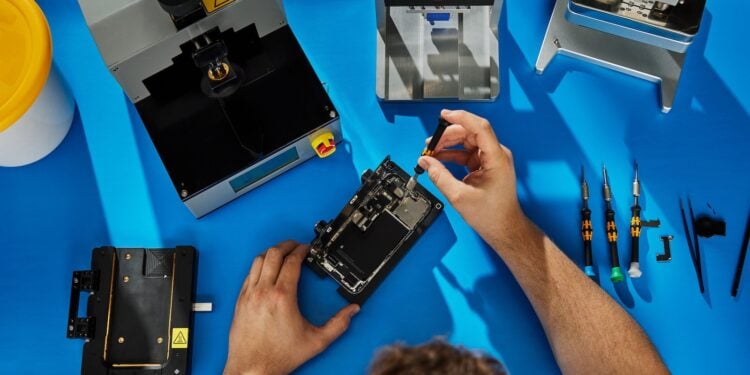Apple has expanded its self-repair program and is now offering genuine parts and tools for the iPhone 17, iPhone 17 Pro, iPhone 17 Pro Max, and the new iPhone Air. This allows users to repair these models themselves for the first time. The parts have been available since this week in the US, Canada, and several European countries, including Germany, France, Italy, Spain, the Netherlands, Belgium, Ireland, Sweden, Switzerland, and the UK.
For years, Apple has stood for closed systems and a controlled repair policy. With the launch of its self-repair program in 2022, this changed. The company is opening up access to original parts, tools, and repair guides to extend the lifespan of its products and enable independent repairs. The goal is to operate more sustainably while simultaneously giving users more freedom in maintaining their devices.
While the program isn't intended for complete novices, it's aimed at technically experienced individuals who feel confident opening their iPhones and replacing components themselves. Apple clarifies that the same components and tools used by authorized service partners can be used.
Genuine parts for all new iPhone models
The updated inventory of the Apple Self Service Repair Store includes replacement parts for key components of the new iPhone generation. These include displays, batteries, cameras, speakers, housing parts, logic boards, and other components. This allows users to perform the most common repairs, such as battery replacements or screen replacements, even outside of authorized service centers.
In addition to the parts, Apple offers the necessary tools. Those who don't own their own equipment can rent a complete repair kit for seven days. In Germany, the rental costs €60. The kits contain specialized tools designed to help with the precise opening and safe reassembly of the devices.
Repair manuals for each model
Apple has published separate repair manuals for each of its new models – iPhone 17, iPhone 17 Pro, iPhone 17 Pro Max, and iPhone Air. These documents are available free of charge on Apple's website and guide users step-by-step through the replacement process for individual components. They specify the necessary tools, provide safety instructions, and include information on torque specifications and screw types.
With this documentation, Apple aims to make repairs traceable and transparent. At the same time, the company retains control over the quality of replacement parts, as only original components are used. This is intended to prevent inferior imitations from entering circulation, which could impair the performance or safety of the devices.
A growing program
The self-repair program has grown in several stages since 2022. Initially, Apple limited it to a few iPhone models, but now the program also includes various iPads, Macs, the Studio Display, and the Beats Pill speaker. With the expansion to the iPhone 17 series and the iPhone Air, the program now also covers the current generation of devices.
Apple continues to emphasize that self-repair is not suitable for everyone. The process requires technical understanding and care, as tampering with the electronics can damage the device if not performed correctly. Anyone who is unsure can still have their iPhone repaired by an authorized Apple service provider or by Apple itself.
Apple is opening up step by step
By providing spare parts and repair instructions, Apple is demonstrating its growing openness to the so-called "right to repair"—the right to repair electronic devices independently. This move also follows increasing political pressure in the US and the EU to demand greater transparency and repairability from manufacturers.
The new offering is part of Apple's strategy to make products more sustainable and extend their lifespan. By replacing components instead of disposing of entire devices, the amount of electronic waste is reduced, and the environment is lessened. At the same time, it creates a new option for those who want to keep their devices in use for as long as possible.
Apple is focusing on more self-repair and sustainability
Apple is expanding its service philosophy with its self-repair program . By making original parts, tools, and repair manuals available for the iPhone 17, iPhone 17 Pro, iPhone 17 Pro Max, and iPhone Air, the company is further opening up the market to DIY repairs. This gives users with technical expertise more freedom to fix defects themselves without having to rely on third-party repair services.
This move underscores Apple's growing focus on sustainability and user autonomy. The company combines technological innovation with responsibility and makes it clear that high-quality devices should not only be durable but also repairable. (Image: Apple)
- M5 iPad Pro Teardown: iFixit Reveals Weaknesses in Repairs
- WhatsApp enhances security with passkeys for backups
- More AI, more advertising: Meta is pushing ahead with the restructuring of its apps
- China and the USA: No real peace in the trade dispute
- AirPods Pro 3: Complaints about noise are increasing
- Apple improves the App Store with new tools and features
- Apple's iPhone Fold is coming in 2026 – that's the perfect moment.
- Apple is now part of the Game Awards advisory board.
- Nvidia reaches $5 trillion – a record in the tech world
- Bank of America raises price target for Apple to $320
- Apple will spend more money on lobbying in Brussels in 2025.
- Apple presents AI dataset for improved image processing
- Apple makes serious allegations against former engineer and Oppo
- Apple releases iOS 26.1 RC – final version is ready
- iPhone Air battery test: A whole day despite small battery
- Apple continues to grow: iPhone boom drives market value to 4 trillion
- Apple's service revenue is expected to reach $100 billion for the first time
- Threads introduces ghost posts – posts that disappear
- WhatsApp introduces new storage management for individual chats
- EU criticizes Meta and TikTok for lack of child protection
- Apple remains strong: JP Morgan now sees price target at $290
- Apple held an exclusive Vision Pro event for developers
- Swift SDK: Android support marks a turning point for Apple





